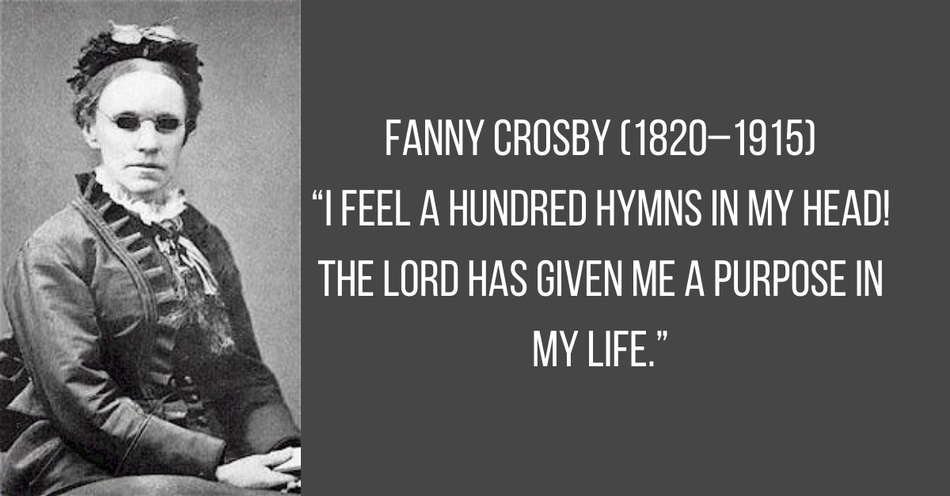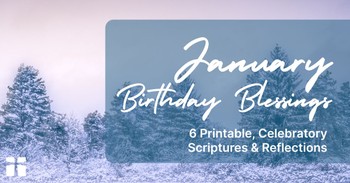Her timeless lyrics still spill from the lips of worshippers on Sunday mornings. Familiar hymns such as “To God be the Glory” and “Praise Him, Praise Him” have blessed millions of Christians since Fanny Crosby once dictated them—unable to write them legibly herself.
But what else do we know about the woman who penned hymns that have endured nearly one hundred fifty years?
Five Important Events in Fanny Crosby’s Life
1. Born March 24, 1820, Frances Jane Crosby endured her first hardship as a six-week-old infant when a visiting physician mistreated an eye infection. The family believed his attempts to treat the infection resulted in total blindness, though some modern experts contend she may have been born with congenital blindness.
2. As fall edged toward winter that same year, Fanny’s father passed away, leaving the baby in the care of her twenty-one-year-old mother, Mercy, and her maternal grandmother, Eunice Paddock Crosby. The struggling family moved to New York within a few years.
3. Determined her granddaughter would flourish despite blindness, Eunice read classics like Shakespeare and Don Quixote to Fanny, taught her about nature, and embedded scripture in her young heart through memorization. Fanny once said, “It was Grandma who brought the Bible to me, and me to the Bible.”
4. Days before her 15th birthday, Fanny joined the New York Institution of the Blind. She flourished in its halls and classrooms and learned to sing and play the organ, harp, guitar, and piano. Fanny transitioned from pupil to teacher in 1847 and shared her skills in grammar, speech, and American history for the next eleven years.
5. William Bradbury, the publisher and hymn writer, changed Fanny Crosby’s life. After the two were introduced on February 2, 1854, Fanny said, “Van, I feel a hundred hymns in my head! The Lord has given me a purpose in my life.” Incredibly, Fanny sometimes composed six or seven hymns each day, memorizing up to a dozen before dictating them to her secretary.
10 Important Quotes by Fanny Crosby
Beyond the beautiful lyrics of her hymns and poems, Fanny’s wisdom is recorded in biographies and from conversations she had with others. Some of her words are listed below.
Quotes about Daily Living
“Live in the moment and make it so beautiful that it will be worth remembering.”
“It may seem a little old-fashioned, always to begin one’s work with prayer, but I never undertake a hymn without first asking the good Lord to be my inspiration.”
“Two of my secrets for staying happy and healthy are to control my tongue and to control my thoughts.”
“One of the easiest resolves that I formed in my young and joyous heart was to leave all care to yesterday and to believe that the morning would bring forth its own peculiar joy.”
Quotes about Faith
“I have not for a moment in more than eighty-five years felt a spark of resentment against him (the doctor), because I have always believed...that the good Lord...by this means consecrated me to the work that I am still permitted to do.”
“God will answer your prayers better than you think. Of course, one will not always get exactly what he has asked for...We all have sorrows and disappointments, but one must never forget that, if commended to God, they will issue in good...His own solution is far better than any we could conceive.”
“The Lord is the sunshine of my soul. To God be the glory!”
Quotes about Suffering
“It seemed intended by the blessed Providence of God that I should be blind all my life, and I thank Him for the dispensation.”
“I could not have written thousands of hymns if I had been hindered by the distractions of seeing all of the beautiful objects that would have been presented to my notice.”
“If I had a choice, I would still choose to remain blind... for when I die, the first face I will ever see will be the face of my blessed Savior.”
10 Things You Probably Didn’t Know about Fanny Crosby
1. Fanny Crosby passionately invested in supporting and ministering to the needy as an urban mission worker. Earning only one or two dollars per hymn, she gave most of her income to the rescue or “gospel” missions in which she served—even moving into the poorest slums of New York City, where she could invest daily in the lives of the hurting about whom she wrote,
“Rescue the perishing, care for the dying,
Snatch them in pity from sin and the grave;
Weep o’er the erring one, lift up the fallen,
Tell them of Jesus the mighty to save.”
2. “Aunt Fanny” engaged in her most ardent urban mission work from age 60-90. Upon her death, Fanny even willed funds toward developing a mission named in her honor, the Fanny Crosby Memorial Home for the Aged. The group operated from 1925-1966, and later continued her legacy as the Bridgeport Rescue Mission.
3. Although some modern scholars contend she may have had congenital blindness, Fanny developed an eye infection as an infant. With the regular physician unavailable, a visiting doctor provided care—insisting her parents place mustard poultices on her eyes. Within a few short weeks, Fanny was declared blind.
4. Fanny Crosby never considered blindness a hindrance. Instead, she attributed her keen memory to a lack of sight. Penning her first poem at the tender age of eight, Fanny wrote about the malady, “How many blessings I enjoy that other people don’t. To weep and sigh because I’m blind, I cannot and I won’t.”
5. Utilizing her power of recall, Fanny memorized numerous books of the Bible as a youth. These included the Pentateuch, the Gospels, the book of Proverbs, the Song of Solomon, and multiple Psalms. She also served as a Baptist deaconess, missionary, and lay preacher. However, Fanny attended many churches across the denominational divide and had close friends in the “holiness movement” of the day.
6. Known as the “Queen of Gospel Song Writers,” Fanny wrote more than eight thousand hymns under various pen names. These included Miss Grace Elliot, Grace J. Frances, Victoria Frances, Jennie Garnett, Robert Bruce, and hundreds more. Although she wrote and published multiple books of poetry, two biographies, cantatas, patriotic and political songs, Fanny prayed her hymns would change lives. Planning to witness to one million men and women through her music, Fanny recorded the names of those who shared they had confessed faith in Jesus.
7. Fanny was a turn of the century influencer. A lobbyist, Fanny advocated for students with special needs. In 1843, she spoke to the United States Senate. The following year, she and a group of other students from the New York Institute for the Blind sang about the importance of providing education for blind students in all states—an effort John Quincy Adams celebrated.
8. Two years later, Fanny also testified before a joint session of Congress.
9. Although Fanny married, she used her maiden name professionally at the suggestion of her husband, Alexander Van Alstyne, Jr.
10. Fanny and Alexander had an unconventional marriage: they lived most of the time separately and pursued individual careers. While they collaborated on musical pieces, they rarely traveled together, and “Van” became reclusive after baby Frances passed away.
The Conversion Story You Should Know about Fanny Crosby
In 1849, a cholera outbreak flooded both the city and the New York Institution of the Blind. Many of Fanny’s friends died.
One night, Fanny dreamed of a friend who appeared close to death. He asked about her eternal salvation. When she awakened, Fanny felt unsettled and began attending numerous church services. While religious and brimming with Biblical knowledge, Fanny did not know Christ as savior.
But the faithfulness of both Fanny’s mother and grandmother was rewarded when, at thirty-one years old, Fanny Crosby asked Jesus to step into her life as Lord. Fanny received assurance of salvation from that moment and was propelled into her hymn writing career.
If you have been on your knees interceding for an adult child bent on religion rather than relationship with Jesus or your heart breaks over those who do not yet know Jesus, be encouraged. Some people who make the greatest impact on the lives of others take time to open their hearts to salvation.
Keep praying, then watch God move.
Photo Credit: Public Domain via Wikimedia Commons

This article is part of our People of Christianity catalog that features the stories, meaning, and significance of well-known people from the Bible and history. Here are some of the most popular articles for knowing important figures in Christianity:
How Did the Apostle Paul Die?
Who are the Nicolaitans in Revelation?
Who Was Deborah in the Bible?
Who Was Moses in the Bible?
King Solomon's Story in the Bible
Who Was Lot's Wife in the Bible?
Who Was Jezebel in the Bible?
Who Was the Prodigal Son?




